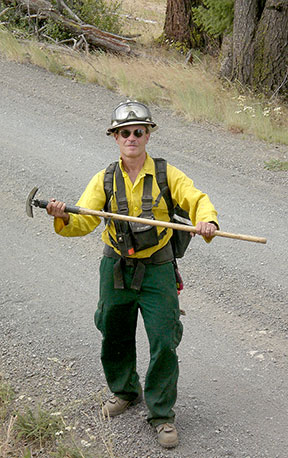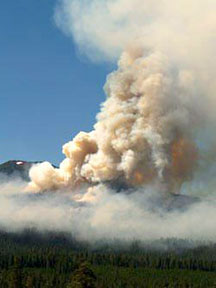 |
Previous Issues |
| Cedar Mill Community Website |
|
Search the Cedar Mill News: |
About The Cedar Mill News |
|
|||||||
| Volume 15, Issue 5 | May 2017 |
||||||
Glenn Segal, firefighter, profile
|
|||||||
 |
| Glenn in his gear |
Forests have been Glenn Segal’s office and career. The Cedar Mill resident has planted hundreds of trees a day, surveyed acres of forests for the U.S. Forest Service, and when fire strikes he lends a hand to keep them from burning up.
“In my 35 years in the woods, I have seen more untouched ground than 99% of people,” he said.
The woods are a far cry from the concrete jungle of New York City where Glenn grew up. The Manhattan native knew city life wasn’t for him, so when he was 25, he left his mother and brother and went to work on a ranch in Roseburg. That was the beginning of his wooded career path.
He spent days chopping wood and tending the ranch’s animals and crops. Eventually he joined the Hoedads, a Eugene-based reforestation cooperative that replanted after clear-cutting. With the Hoedads (named for the implement used to plant bare-root trees), he learned how to plant a lot of trees quickly. “I could plant 500-600 trees a day, though some of the go-getters could do 1,000,” he said.
After several seasons doing that, and an acting stint (he had a part on the 1980s series “Quantum Leap” and some TV commercials), he moved into timber surveying that took him deep into the woods, assessing trees for the Forest Service. Being out in the wilderness alone was “kind of freaky sometimes,” he said, like the time he heard strange growling sounds that turned out to be bear cubs playing nearby.
“I thought, ‘I’ve got to get out of here,’” he recalled. Quickly finishing the plot he was surveying, he moved uphill and upwind of the cubs. “Then I saw mom come charging right where I had been standing.” The mother black bear was a short distance away, but she couldn’t see or smell Glenn, who counted himself lucky to have been warned by the cubs’ play noises.
 |
| This picture of the retardant planes was from Glenn's lookout point on the Castle Rock (Idaho) fire |
His tales of forest life haven’t all been exciting, but they have been instructive. From 20 years of timber surveying, he’s got a botanist’s knowledge of native plants and their preferred habitat. He’s also got some of the best-looking “office space” of anyone. What did he love about his work? “The beauty, the solitude, wildlife, exercise. Every location is different in some way.”
But with marriage and the births of his two children, Quinn, 17, a senior at Sunset High School, and Gabriela, 14, an eighth grader at Cedar Park Middle School, he decided to stick closer to home. But his love of vintage vehicles brought him back into the woods—this time as a firefighter.
He bought a 1964 Ford fire engine that he thought he could contract out to the Forest Service. The fire engine turned out to be past its prime, according to the Forest Service, but Glenn wasn’t. After passing a fitness test, he joined a hand crew the summer of 1999. For most of the past 18 summers he’s headed a 20-person crew of wildland firefighters battling blazes in the Pacific Northwest and beyond. With his vast knowledge of forests, physical fitness, and fluency in English and Spanish, Glenn seems a natural for the work.
 |
When the rains stop and the Northwest heats up, he knows the call could come any time that would pull him back into the woods, burning woods this time. He’s ready. “I love the excitement of it. The science of fire is fascinating,” he says, adding the camaraderie and pay are pluses too.
The danger of wildfire fighting is well known and Glenn has stories, like Idaho’s 2007 Castle Rock fire, when he was a lookout for hand crews setting back fires. Suddenly, the wind changed and the fire leapt into the crown of trees, moving with the sound and speed of a freight train toward the crews, who were quickly evacuated.
“As a crew boss, I’m not digging. My job is to be aware and make sure my guys are safe,” he says. “Safety is the most important thing.”
Glenn is looking for new recruits who would like to fight fires and collect their own stories—and make good money—this summer. Starting pay is $11.50 hour and averages about $16 per hour with hazard pay. Applicants must pass a “pack test”—carrying a 40-lb. pack for three miles in under 45 minutes and be available on-call from June through October. A four-day training course is planned for late May. Email forestglen54@hotmail.com or call (503) 312-6915.
![]()
Like us on Facebook for timely updates
Published monthly by Pioneer Marketing & Design
Publisher/Editor:Virginia Bruce
info@cedarmillnews.com
PO Box 91061
Portland, Oregon 97291
© 2017